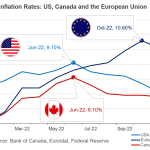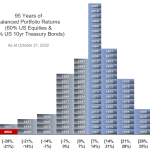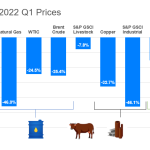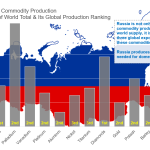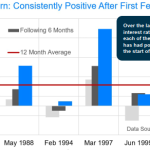|
If
the embedded document is not visible above, then the text and
charts of the newsletter can be viewed below in html format: The Challenges of Oversupply
 T his edition of our newsletter takes a look at a topic that we think deserves more attention from investors and policy makers. Since the end of the last recession, there has been much debate around the topic of why the global economy has not been more responsive to the more than 500 interest rate cuts and massive injections of monetary stimulus by the world’s central banks. Many
of the explanations that have been offered to explain why economic
growth has been sluggish since the end of the last recession are
explained by the idea that there is a global deleveraging
underway. Governments, consumers and businesses that became
too deeply indebted during the boom times are focusing on paying down
debt instead of consuming. The focus on debt repayment means that
governments and consumers are not willing to spend money on goods and
services – effectively holding the economic growth in
check. For
a different perspective on what ails the global economy, author Daniel
Alpert argues in his book ‘’The Age of Oversupply’’ that due in part to
the effects of a more globalized economy, there is simply too much
capital, too much labor and too much productive capacity producing too
many goods. Against this backdrop, Alpert argues that simply flooding
the financial markets with central bank generosity in the form of easy
money and low interest rates will make the problem worse – not
better.  The prevailing belief had The prevailing belief had
been that globalization would usher in a period of unrivalled
prosperity. By the late 1990s, some had begun to boldly question aloud
whether the business cycle and recessions were a thing of the
past. This belief seemed reasonable given how fast the global
economy had begun to accelerate. However, by the turn of the century
this optimism was being questioned. Europe began to
show signs of persistent slow economic growth and the US economic
rebound was being seen as a debt fuelled experiment that would
eventually have to be reckoned with. The
bursting of the real estate bubble globally ushered in a period of
persistent economic sluggishness and a reassessment of the real impact
of globalization. Perhaps Alpert’s thesis is best illustrated by his
statement: The Cold War’s end
was widely seen as a triumph for liberal free-market democracies, …
Infact, in a grand irony, the demise of the socialist experiment set
the stage for the greatest threat yet to the supremacy of the United
States and other advanced economies. A
Rising Pool of Workers
To
better understand the mechanics of Alpert’s argument, a key ingredient
to economic growth must be examined—labour. Economic reform
in developing nations has allowed nearly 2 billion more workers to be
brought into the global labor force. The developing world has used its
advantage of cheap labor to enhance economic growth. Their formula for
the most part was to use this labour force as a competitive advantage
to export their output to wealthier developed nations. For
developing economies, the expectation was that lower wage nations would
provide cheaper manufactured goods and in turn they could transition
towards more value added industries. All was expected to be well as new
consumers in developing nations would emerge and begin to spend like
those in the developed world. Therefore there could not be
too much capacity, too much labor, or too many goods. Unfortunately,
the outcome and the theory diverged. The
reality has been that for many individuals in developed
nations, wages and incomes have been largely stagnant.
Meanwhile debt levels of governments and consumers have risen to
exceptionally high levels. It is the repayment of this
debt that many believe is holding the economic growth engine in check
today. Therefore,
the problems of today have their roots going back to overspending that
began over two decades ago. To summarize: There has been too
much spending in the west and not enough spending in the east. Why
Aren’t They Spending
Policy
makers and academics are forever talking about productivity. The
simplest definition of productivity is the amount of economic
output achieved from an amount of labor and
capital. In order for a nation to improve its standard of living and
for incomes to rise, it must be able to raise its productivity so that
more wealth can be generated for a given level of wages and industrial
capacity. An abundance of labour and an economic model devoted to growth through exports has been one of the main reasons for the high economic growth rates of developing markets. As a result, the incomes in the developing world are rising faster than the global average but much of this income is being saved at a much higher rate than expected. Part of the reason that their savings rates are so high is that there
is no significant social safety net such as national pensions or health
insurance programs. In addition, some Asian nations such as China are
seeing their populations becoming older and these societies are less
interested in consumption and more focused on funding retirement and
general well being by enhancing their savings levels.  Click here to view a larger version of this chart. Capital:
Asia’s Largest Export
The question that now arises is
“If the income from emerging markets isn’t being spent, where is
it?” The pool of savings from the developing nations of Asia
and other parts of the world has actually made its way into North
America and Europe in the form of debt. As the income earned
by the developing nations is recycled into borrowing (debt) by the
governments and consumers of the developed nations, downward pressure
is exerted on interest rates. After all, interest rates are really the
cost of money—if money is in ample supply from the emerging nations
then borrowing was cheap. The chart above demonstrates just how ample the supply of money has been. Foreign currency held in reserves of developing economies now have surpassed $7.2 trillion USD which is equivalent to 10% of the global economy. This has increased 224% over the last several years. Stagnant incomes in the west have been offset by this cheap credit from
abroad. The
lower the interest rates went, the easier it was to borrow and buy
goods and services. To make a rather simplistic summarization –
developed nations borrowed and consumed and emerging nations produced
and saved. The problem is that for too long, the developed world has been
borrowing faster than its income has risen – creating a debt burden
that is rising faster than the economies of these nations can
payback. Alpert states that as long as the charade continued
everybody won – until events such as the Financial Crisis brought the
problems of debt out into the open.
Building
Bubbles The
optimists will argue that cheap capital can be beneficial. It
can be deployed as indeed into the economy through lower borrowing
costs that enable the construction of everything from new factories and
infrastructure to consumers being able to buy bigger houses, cars and
other discretionary items. The problem now is that after a
prolonged period of cheap capital and low interest rates going back for
over a decade, there might be too much plant and industrial capacity
that has already been built. Any further expansion will only make the
situation worse. The
concerns over cheap capital have been echoed before. When the US real
estate market was approaching its 2006 peak, US Federal Reserve
Governor Susan Bies was quoted telling her fellow Fed Governors that “… my
concern relates to the tremendous amount of liquidity … in the
banking sector, in the U.S. financial markets, and … globally.
…this liquidity is something that we really need to think about. … I
do worry that liquidity is, … causing a lot of transactions to occur
that economically perhaps wouldn’t otherwise occur.” Bies
was basically saying that this tide of cheap money was inducing people
to take risks or make purchases and investments that they would
otherwise have foregone. If so, then you have the makings of a bubble
if it goes on long enough. So
the question policy makers must ask themselves is whether their
solutions are creating new problems for the future.
In short, “Are bubbles forming as a result of liquidity (money supply)
being higher today than at any other time in history?” As of
September 2013, the global money supply has reached an astounding $66
trillion. Low
Interest Rates Have Limits The
go-to solution from central banks thus far is really the only one that
they can come up with – lower interest rates and inject even more money
into the financial system. It has worked to help stabilize the housing
market and the financial markets globally. But it has not solved
challenges facing global labor markets nor can central banks provide
the legislative changes needed to confront these challenges. That is
work that only government policy can do. Aging
Populations One of the most important underpinnings of a strong economy is a population with a growing working age population (labor force). In much of the world, the working age population is either close to peaking or has peaked. This is not something that an interest rate cut or cheap money can fix. It will require countries with ageing populations to modify their immigration policies to attract younger and more educated workers. The issue is that there are a number of countries facing this challenge so there could be a growing competition amongst countries for these types of individuals. According to updated census data in the US, it is now expected that the
US population growth will slow more than expected over the next several
decades due to less individuals coming to the US from abroad and a
slowing in the birth rate forecasts. For example, the US used to
receive a steady flow of workers from Mexico but in recent years, net
immigration from Mexico is thought to be close to zero as tighter
border security and slower economic growth reduce the incentive to
enter into the US. So the US has achieved a victory over this long
standing border security problem with its southern border but the
economic implications of an ageing population are not talked about very
often. A shrinking work force coupled with stagnating productivity growth
inhibits a nation’s ability to generate wealth and prosperity for its
citizens. There are no easy answers and perhaps these
concerns will prove over the long term to be without merit. But at the
very least, they should be considered. Summary The first part of the job of policy makers was to stabilize the
financial markets. To that end, “Mission
Accomplished” would be an appropriate slogan.
The other challenges and imbalances will take time and policy making
that rises to the level of the challenge.
However, one thing is clear, ultra low interest rates and excessive
money supply increases are not without risk. Stocks markets
appear to be fair valued and bond markets can only deliver decent
future returns if interest rates were to decline significantly from
current levels. That would take another economic downturn—which at this
point is not on the horizon. A meaningful rebound
in economic growth globally would begin to set
investors at ease that the world can wean itself off of the liquidity
spigot. While that may take some time, it is a necessary
reset that policy makers should begin to
focus on.

Pacifica
Partners Capital Management Inc.

This
report is for information purposes only and is neither a solicitation
for the purchase of securities nor an offer of securities. The
information contained in this report has been compiled from sources we
believe to be reliable, however, we make no guarantee, representation
or warranty, expressed or implied, as to such information’s accuracy or
completeness. All opinions and estimates contained in this report,
whether or not our own, are based on assumptions we believe to be
reasonable as of the date of the report and are subject to change
without notice. Past performance is not indicative of future
performance. Please note that, as at the date of this report, our firm
may hold positions in some of the companies mentioned.
Social
Media: It is Pacifica Partners Capital Management Inc.’s policy not to
respond via online
and social media outlets to questions or comments directed to it or in
response to its online and social media
publications. Pacifica Partners Capital Management Inc. does
not
acknowledge or encourage testimonials posted by third party
individuals. Third party users that have bookmarked Pacifica
Partners Capital Management Inc.’s social media publications or profile
through options
including “like”, “follow”, or similar bookmarking variations are not
and should not be viewed as endorsement of Pacifica Partners Capital Managemetn Inc., its
services, or future or past investment performance. To view our full
disclaimer please click
here. Copyright
(C) 2013 Pacifica Partners Capital Management Inc. All rights reserved. |
|
|
|
